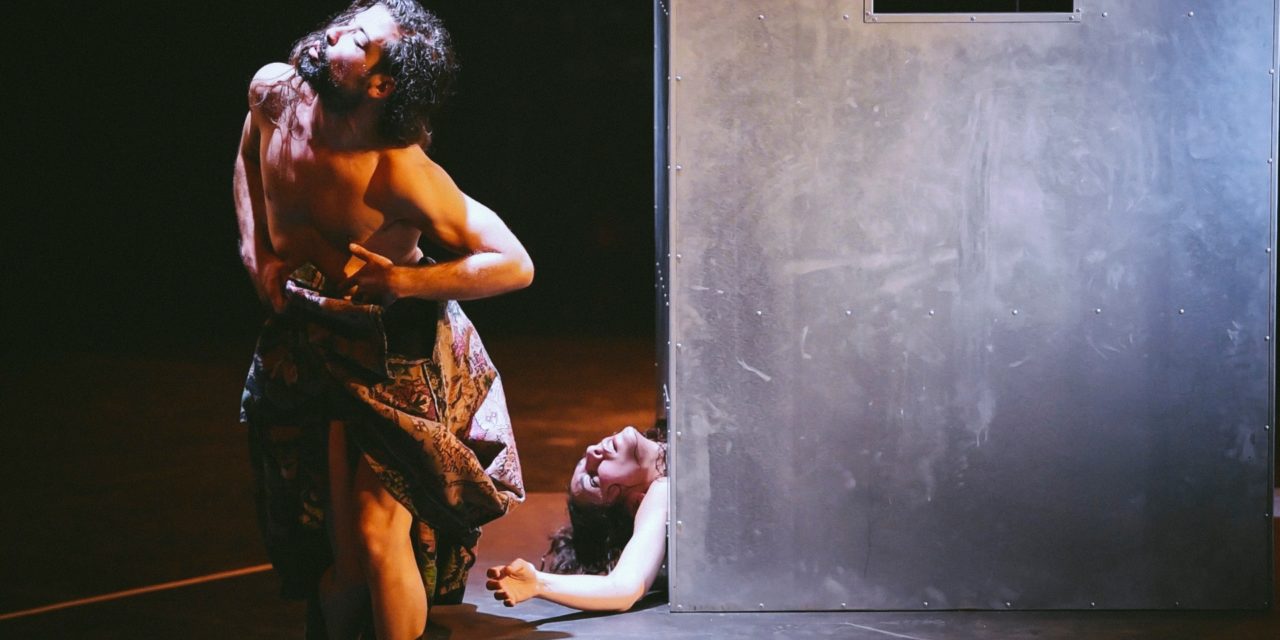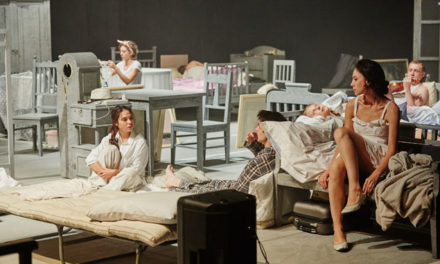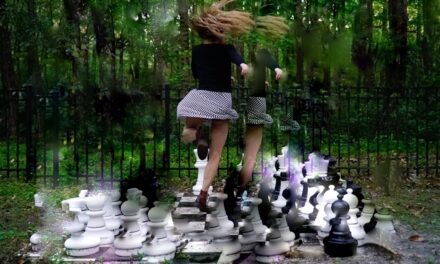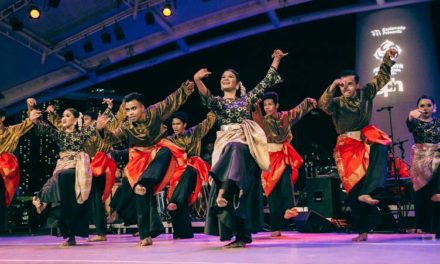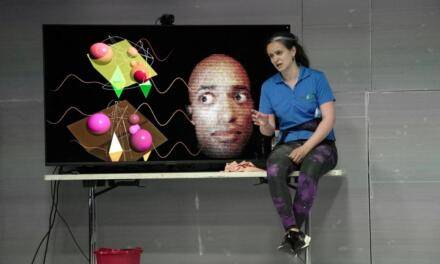The interview was conducted in Guimarães, Portugal, on October 8, 2016, after I saw his play Nós Matámos o Cão Tinhoso at Centro Cultural Vila Flor there.
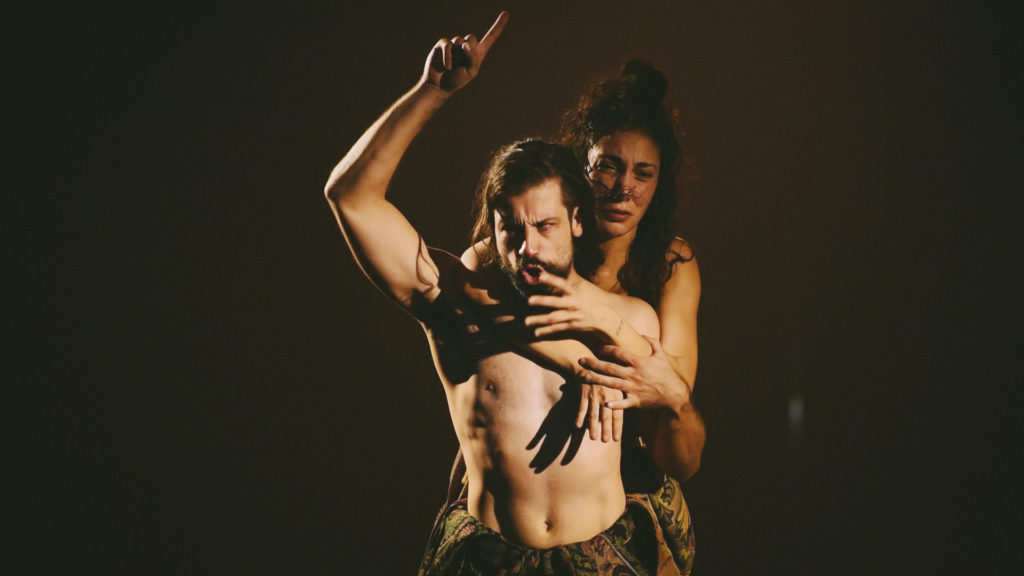
Nós Matámos o Cão Tinhoso (We Killed Mangy Dog). “Não vos vou dizer o que estou a pensar porque trago um fantasma agarrado a mim; e tenham cuidado com a espada em que o meu dedo se pode tornar.” Translation: “I will not say what I am thinking why bring a ghost clinging to me; and be careful with the sword where my finger can become.”
Fadi Fayad Skeiker: Tell me about your life and work.
João Garcia Miguel: I began working with music; I used to be a rocker and a fan of rock music in my early youth. I am also interested in poetry, and literature, but when I started thinking about enrolling in the university, I did not know what to study, as I did not have a clear vision that I wanted to be an artist. I started to study engineering, following in the steps of my dad, then architecture, before I eventually moved to fine arts. While studying fine arts, I started doing installations and site-specific art projects; then I was invited by an actress to work with her group and started doing theatre. Then, I created a group that became very well known in the 90s, and I called it “the eye.” Even though I was the founder of that group, I ended it in 2002. Then I began working alone. I produce, direct, and work with actors who sometimes follow me. Most of the work I do is with people who have worked with me for years, and I have a deep relationship with them.
FFS: Let’s talk a little about the play I just saw, Nós Matámos o Cão Tinhoso (We Killed Mangy Dog and Other Stories).
JGM: The story is from Mozambique and is found in a collection of short stories with the same title, by Luís Bernardo Honwana. The book was first published in Portuguese in 1964. I focus on the story about a boy who is marginalized and is an outcast, and he is supposed to kill a stray dog to be accepted. I blend this story with another about a little kid who is experiencing a difficult night. He is describing his house, how he sleeps with his siblings, how his mother has a better mattress than the others, and the way his brother snores, the sound of the house. Then, he describes the house itself; the walls of their house become dark because they cook inside it, and they built a little hut in the yard to do the cooking, but it is packed too, when someone sleeps there, and the dog sleeps there as well. After that, he describes his relationship with his father, who sleeps on a hard mattress, and he talks about how strict his father is with him. So I mix this story with the other one, where I see in the second story the inner soul of the child from the first story.
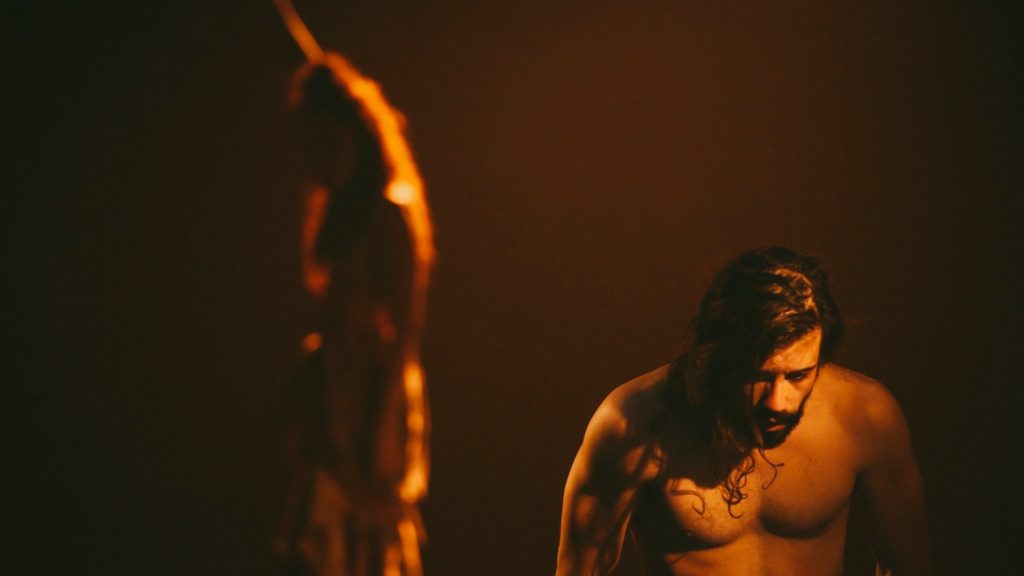
Nós Matámos o Cão Tinhoso (We Killed Mangy Dog). “Gostava de sentir os meus pés a tocar o céu tal e qual sinto a terra a mexer-se debaixo dos meus pés.” Translation: “I liked to feel my feet touching the sky just like I feel the earth move beneath my feet.”
FFS: How did you approach working on the text?
JGM: I read both stories as texts that talk about European reality now. These texts discuss a kind of universal situation related to manipulation of power. The exact way we deal with reality in European terms, the way we perceive colonial processes, and the way that men with power use their statuses to send others to war.
FFS: Can you tell me more about this dynamics and how it is personalized in your work? I will play devil’s advocate and say that you are exercising your power as European Portuguese by bringing an African text, making it yours, and presenting it in Portugal with a European cast for a European audience. I am sure there is something more behind that, and I want to hear it from you.
JGM: This is not a political project, yet I do want people to go through an aesthetic process that is so strong that it forces them to rethink structures of power. I believe in the transformative power of theatre in this world, this is my utopia, but my play is not a political manifesto. It is a project where we, as artists and spectators, should think about ourselves and think, Why do we fear the other? Why are we afraid of the presence of the other? Why do we develop a society that gets us there?
I am now interested in going back to the writings of Portuguese early travelers going from here to touch one sea after the other, and then trying to dominate the other. It is part of history, but personally, this fight is part of me now, as my social environment teaches me how to colonize the other and kill the other, and this work as well as my next work, are reflection processes about that: theatre is a way for me to face my fear.
FFS: This might be your way of decolonizing your fear and the way you perceive the other?
JGM: This is exactly what I am doing. I do not need people to tell me how we can change, as I do not believe in changing the world as a political project: the only possible way to change is to change the self.
FFS: Facing the fear means facing the way you were brought up to exclude the other?
JGM: Yes, all of us as world citizens are brought up one way or another on that fear; it is part of us, and we need to face it in order to survive. We need to be doing this because we need to grow together.
FFS: There is a physical intensity in the performance: it’s a highly charged performance. How is that physical intensity serving and balancing the story? I am curious to know the process that you go through to embody the narration.
JGM: I put the actors to rehearsal, and work on our sources of communication and archetypes. And we work and research physical movement, African movement; we also do lots of research with Portuguese popular dance and African dance; we are not concerned with anything but something that goes deep and could be communicated across many cultures. Our goal is to make a connection with each spectator in the room as an individual and not as a mass. Sometimes we spend lots of time on working on sound and movement and stay away from the text. The process starts with putting the body in a burning stage. Having said that, I do value working on the text, the narrative of the text in the play, as I do believe that while the world is falling apart, we as human beings need something to hold us, and narrative in general, the narrative of each story I present, might be the answer.
FFS: What about the visual vision of the play? There is a hut, a piano and actors’ bodies. How do you approach the play you direct visually?
JGM: I see vague visions that might not be clear at the beginning; I am always doing visual/writing/rehearsing at the same time: they are related processes. I imagine a hut, a metal one; then I build it, and ask the actors to interact with it. After building it, I go on one of my trips to Africa and I see lots of these huts, and then I see that connection that has been growing unconsciously in my imagination. African landscapes are full of metal huts, and they use them there to “colonize” the land and claim the ownership of the land that they build their huts on. After learning that fact, the metal huts become a connection to owning the land.
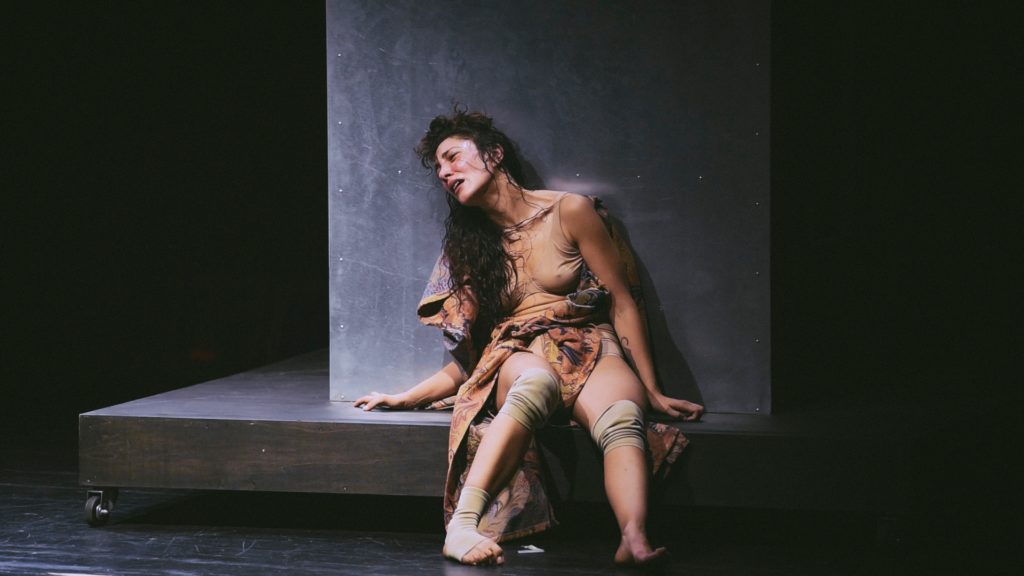
Nós Matámos o Cão Tinhoso (We Killed Mangy Dog). “O meu coração está frio e cheio de música; assim como as minhas costas sentem a dureza desta parede de metal, o meu corpo chora e liberta-se de mim.” Translation: “My heart is cold and full of music; as well as my back feel the hardness of this metal wall, my body cries and freed from me.”
FFS: Do you see anyone from your childhood as an individual audience?
JGM: Sometimes yes, they are part of my inner spectators; less and less as time goes on, but it depends. In this play, for example, my father is very present. I mean all my fathers, not necessarily my biological father. I have many spectators inside me and I use them all the time; they are present in me. I work with my two eyes and, too, several eyes inside of me; this is the way I “colonize and decolonize” the voices inside me.
FFS: How would you describe the play to someone who did not see the play?
JGM: The play is about ceremony, about freedom of life, about how people will come to change after encountering the beauty of art. This is a ceremony about violence and beauty, a mirror that will help the spectator to be a little different.
FFS: Where is this play going next?
JGM: To Lisbon, where it will be performed in a big church, and then to Angola. In Angola, I will workshop it with collaborators there.
FFS: How do you contextualize all of your trips to Africa within the framework of international artistic collaboration?
JGM: In this particular project, collaboration is there from the start: there was lots of talking and brainstorming. We had a plan to execute, and we could not, as we were advised not to go to Angola while it is undergoing unstable, rough times. We are working more and more abroad, and we go to Portuguese ex-colonies, to perform and develop the work there; it is a kind of emotional relationship with Africa. I go to Angola twice a year, for example; over the years, we’ve connected with artists and groups and we’ve developed training plans. This particular project that you just saw began in Angola in 2015. It was perceived as a starting point to collaborating, but Angola had begun a period of instability, and collaboration was put on hold. I went on with the project in Portugal, but I plan on taking the play to Angola in December, and will workshop the play in collaboration with artists there.
FFS: Thank you for this interview!
JGM: Thank you. It is a beautiful moment for me.
This post was written by the author in their personal capacity.The opinions expressed in this article are the author’s own and do not reflect the view of The Theatre Times, their staff or collaborators.
This post was written by Fadi Fayad Skeiker.
The views expressed here belong to the author and do not necessarily reflect our views and opinions.

